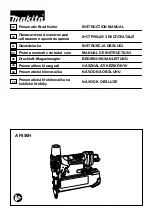
6
portion of the tool operating controls is inoperable,
disconnected, altered, or not working properly.
•
Do not attempt to keep the contact element
depressed with tape or wire. Death or serious
injury may occur.
•
Always check contact element as instructed in this
manual. fasteners may be driven accidentally if the
safety mechanism is not working correctly.
•
When not operating the tool, always lock the
trigger by turning the lock lever to the LOCK
position.
•
Make sure that the trigger is locked when the lock
lever is set to the LOCK position.
Loading fasteners
•
Do not load the tool with fasteners when any one
of the operating controls is activated.
•
Use only fasteners specified in this manual. The
use of any other fasteners may cause malfunction
of the tool.
Power source
•
Never connect the tool to compressed air line
where the air pressure can exceed the suitable air
pressure range of the tool, specified in the
"SPECIFICATIONS" table, by 10%. Make sure that
the pressure supplied by the compressed air
system does not exceed the suitable air pressure
range of the tool. Set the air pressure initially to
the lower value of the suitable air pressure range.
•
Operate the tool at the lowest pressure required
for the application, in order to prevent
unnecessarily high noise levels, increased wear
and resulting failures.
•
Never use the tool with other than compressed air.
If bottled gas (carbon dioxide, oxygen, nitrogen,
hydrogen, air, etc.) or combustible gas (hydrogen,
propane, acetylene, etc.) is used as a power
source for this tool, the tool will explode and cause
serious injury.
•
Always disconnect the air hose and remove all of
the fasteners:
−
when
unattended;
−
before performing any maintenance or
repair;
−
before cleaning a jam;
−
Before moving the tool to a new location.
•
Use only pneumatic tool oil specified in this
manual.
Operational safety
•
Always check the tool for its overall condition and
loose screws before operation. Tighten as required.
•
Handle the tool carefully, as there is high pressure
inside the tool that can be dangerous if a crack is
caused by rough handling (dropping or striking).
Do not attempt to carve or engrave on the tool.
•
Stop the operation immediately if you notice
something wrong or out of the ordinary with the
tool. An improperly functioning tool must not be
used.
•
Do not point the ejection port at anyone in the
vicinity. Keep hands and feet away from the
ejection port area.
•
Always assume that the tool contains fasteners.
•
Never point the tool toward yourself or anyone
whether it contains fasteners or not.
•
Do not rush the job or force the tool. Handle the
tool carefully.
•
Do not activate the tool unless the tool is placed
firmly against the workpiece.
•
Never hold or carry the tool with a finger on the
trigger or hand it to someone in this condition.
Accidental firing can cause serious injury.
•
Never use fastener driving tools marked with the
symbol "Do not use on scaffoldings, ladders" for
specific application for example:
−
when changing one driving location to
another involves the use of scaffoldings,
stairs, ladders, or ladder alike constructions,
e.g. roof laths;
−
closing boxes or crates;
−
fitting transportation safety systems e.g. on
vehicles and wagons.
•
Check walls, ceilings, floors, roofing and the like
carefully to avoid possible electrical shock, gas
leakage, explosions, etc. caused by striking live
wires, conduits or gas pipes.
•
Do not use the tool for fastening electrical cables.
It is not designed for electric cable installation and
may damage the insulation of electric cables
thereby causing electric shock or fire hazards.
•
Watch your footing and maintain your balance with
the tool. Make sure there is no one below when
working in high locations, and secure the air hose
to prevent danger if there is sudden jerking or
catching.
•
On rooftops and other high locations, drive
fasteners as you move forward. It is easy to lose
your footing if you drive fasteners while inching
backward. When driving fasteners against
perpendicular surface, work from the top to the
bottom. You can perform driving operations with
less fatigue by doing so.
•
A fastener will be bent or the tool can become
jammed if you mistakenly drive fastener on top of
another fastener or strike a knot in the wood. The
fastener may be thrown and hit someone, or the
tool itself can react dangerously. Place the
fasteners with care.
•
Do not leave the loaded tool or the air compressor
under pressure for a long time out in the sun. Be
sure that dust, sand, chips and foreign matter will
not enter the tool in the place where you leave it
setting.
•
Never attempt to drive fasteners from both the
inside and outside at the same time. Fasteners
may rip through and/or fly off, presenting a grave
danger.
Содержание AF550H
Страница 62: ...62 ...
Страница 63: ...63 ...
Страница 64: ...64 Makita Corporation Anjo Aichi Japan www makita com 884806C975 ...

































